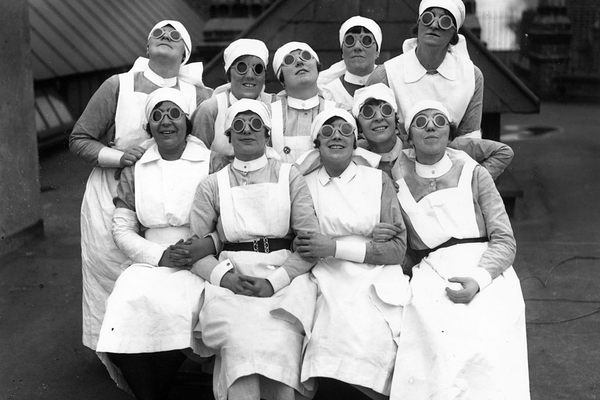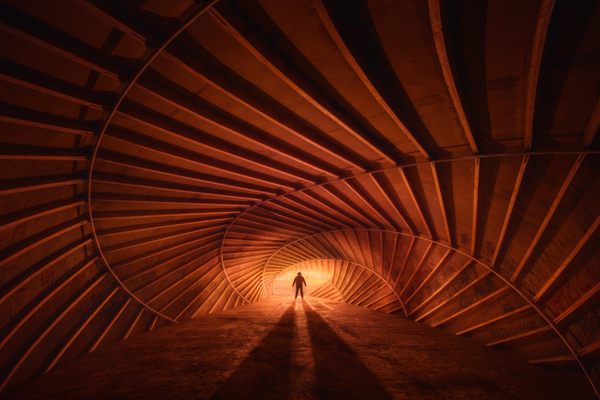The Hypnotic Allure of Cinemagraphic Waves
They rise, swell, or crest—but never truly break.
Ocean waves are, by definition, in a constant state of motion. They swell, surge, crest, and break, and then ebb into another pulse of water. For a photographer, capturing this process requires impeccable timing—a sense for that moment when a wave will rise, or crash, or form a perfect barrel—so that the image is frozen in time but also captures the essence of movement. Ray Collins is a master of that moment, and has won awards for his deep, textured photographs of mountainous waves and roiling seascapes.
Cinematographer Armand Dijcks had been experimenting with animating splashes of water when he first encountered Collins’s photographs. He wondered if he could show the waves “in motion, but staying in place at the same time,” he says. “The idea was to stretch out the 1/8000th [of a] second during which the image was created into infinity. In a lot of my work, I like to mess with people’s minds a little, and this contrast between a very short time span being stretched infinitely long, and between motion and stillness is a perfect example of that.”
After he created a rough example to show Collins—“He immediately liked the idea,” he says—Dijcks set to work. The result is a series of moving-yet-still images, known as “cinemagraphs.” This relatively new technique involves manipulating a still image to create looped, recurring motion. The effect can be startling. They’re photographs that move, or videos that refuse resolution.
Named “The Infinite Loop,” his series of cinemagraphs include cliffs that bristle but never collapse, eternal tubes, and rising edifices of water. Atlas Obscura spoke with Dijcks about the particular challenges of water and the benefits of collaboration.
How do you create a cinemagraph?
You usually start with a few seconds of video footage. You then create a mask that reveals the motion only in certain parts of the image, with the rest being still. The motion is then looped so that it will continue endlessly. Although it’s possible to do the masking and looping in Photoshop, I prefer to use a dedicated application, called Flixel Cinemagraph Pro, that speeds up the whole process significantly. But you don’t necessarily have to start with regular video. You can also use time lapse footage, or, as in case of my wave cinemagraphs, animated stills. In those cases the process usually becomes a lot more involved, and you might need additional software. In my case, for example, I used After Effects for the animation.
How do you and Ray collaborate?
The way it usually works is that Ray sends me a selection of high resolution images, from which I pick a number of candidates that I think will work well in motion. I start working on those, and a few of them make it to the cinemagraph stage. For our recent cinemagraph film The Infinite Now, we worked with two talented Dutch musicians, André Heuvelman and Jeroen van Vliet, who created a custom soundtrack inspired by the wave cinemagraphs. I personally very much enjoy this kind of collaboration with talented artists, because the result ends up having way more “depth” than what one person could probably create by themselves.
What is the biggest challenge in creating a wave cinemagraph?
The motion of the waves is sometimes unexpectedly complex, with different parts of the image moving in different directions at once. Our brains have an intuitive understanding of how water moves, so if the motion doesn’t look natural, the viewer will immediately pick up on that and it will break the illusion. On top of that, not every type of motion is easy to loop. It usually involves a lot of trial and error, and some images that I thought would work great as cinemagraphs turn out not to work at all.
What does a cinemagraph have on a photograph or film?
I’ve always been interested in exploring the intersection of moving images and stills. In my mind these are not really separate things, but two sides of the same coin. At some point I started with time-lapse photography, and based on that created a “long-exposure time-lapse” technique, which blends series of stills to look like a moving, long-exposure image. After that I started experimenting with something I call “morphlapse,” very short time-lapses that are extreme stretched out in time, creating a surreal effect.
Cinemagraphs are a continuation of this path, a different way of blending stills and motion in interesting ways. Like the other techniques, a good cinemagraph usually makes you do a double take, and wonder what you’re actually looking at. It’s an effect that scientists call “cognitive dissonance.” Your brain gets two different inputs, a still image and an element of motion, and is trying to make sense of what’s going on. This makes the viewer engage with it more actively. Very often I’ll combine my previously developed techniques with cinemagraphs to create multiple levels of cognitive dissonance.
A cinemagraph can make you really explore a moment in time in a different way than a photograph or film can. In a photograph you loose the sense of motion. Having that motion can literally add another dimension to how you experience the image. In a film on the other hand, you do have the motion, but the moment is over very quickly, so you hardly have time to take it in.
On top of that, in a cinemagraph you can selectively direct the viewer’s attention to certain subtle motions that one otherwise wouldn’t notice, while freezing everything else. For example, the subtle motion of a leaf on a tree in a busy street, with the motion of the traffic and pedestrians frozen in time. Normally you would never notice the motion of that leaf, because it would be visually overwhelmed by all the other motion.
What other subjects do you think might lend themselves to this treatment?
At the moment I’m working on a series of cinemagraphs based on images of the planet Saturn and its moons, taken by NASA’s Cassini spacecraft. I’m using a technique similar to the wave cinemagraphs. I’ve previously created cinemagraphs based on time-lapse images shot from the International Space Station. Given that I’m a bit of space geek, these series have been a lot of fun to work on.







Follow us on Twitter to get the latest on the world's hidden wonders.
Like us on Facebook to get the latest on the world's hidden wonders.
Follow us on Twitter Like us on Facebook